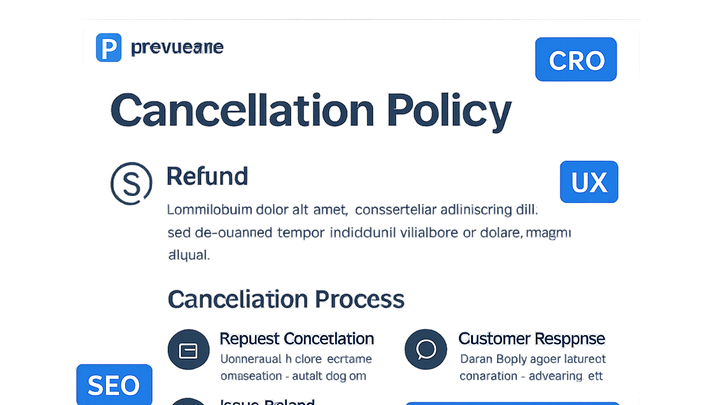Published on 2025-06-29T20:29:46Z
What is a Cancellation Policy? Examples of Cancellation Policies
A Cancellation Policy outlines the terms under which customers can terminate a service or subscription, detailing eligibility, timelines, refund conditions, and the specific steps required. In the context of CRO, UX, SEO, and accessibility, a transparent and accessible cancellation policy reduces friction, builds user trust, and can improve search visibility. It also ensures compliance with consumer protection regulations by clearly stating refund criteria and deadlines. For maximum lead generation, tools like Prevue.me provide actionable critiques on policy clarity, layout prominence, keyword usage, and accessibility considerations. By testing different placements and phrasings, teams can optimize their cancellation policy page for higher conversion rates and lower support inquiries. An effective policy balances user transparency with business protection, turning a potential churn point into an opportunity for feedback or upsell.
Cancellation policy
Defines how users can cancel services and receive refunds, crucial for trust, compliance, and CRO/SEO optimization.
Why a Cancellation Policy Matters
A clear cancellation policy enhances user trust, reduces uncertainty, and ensures legal compliance. It is a critical component of UX design and CRO strategy, as it can influence purchase decisions and reduce support costs.
-
Building trust
Transparent policies reassure users that they can exit if their needs change, boosting confidence in the brand.
- Transparency:
Clearly display deadlines and refund conditions to avoid hidden surprises.
- Reducing anxiety:
Explicitly outline steps to cancel, minimizing user frustration.
- Transparency:
-
Legal compliance
Defines business obligations under consumer protection laws and avoids disputes.
-
Conversion impact
Well-communicated cancellation terms can increase sign-up rates by lowering perceived risk.
Key Components of an Effective Cancellation Policy
Breaks down the essential elements to include in your cancellation policy to ensure clarity, completeness, and user-friendliness.
-
Clear eligibility criteria
Specify who is eligible to cancel, under what conditions, and within what timeframes.
- Timeframes:
Define the exact period when cancellations are allowed, such as 30 days after purchase.
- Service types:
Indicate if all services or only certain plans are cancellable.
- Timeframes:
-
Refund and billing details
Explain how refunds are calculated, processed, and any non-refundable fees.
- Full vs partial refunds:
State whether users receive full or prorated refunds after cancellation.
- Processing times:
Provide clear timelines for when refunds will be issued.
- Full vs partial refunds:
-
Step-by-step cancellation process
Offer a simple, guided procedure that walks users through each step needed to cancel their service.
- Online form:
Provide a form on the account settings page to submit cancellation requests.
- Email request:
Allow users to cancel via a dedicated support email address.
- Confirmation notice:
Send an immediate confirmation message upon successful cancellation.
- Html snippet example:
<div class="cancellation-policy"> <h2>Cancellation Policy</h2> <p>You may cancel within 30 days for a full refund.</p> </div>
- Online form:
-
Contact and support information
List the channels users can use for questions or appeals related to cancellation.
- Support hours:
Include your customer support availability and time zone.
- Multiple channels:
Offer phone, email, and chat options for assistance.
- Support hours:
SEO and UX Best Practices for Cancellation Policies
Guidelines to optimize your cancellation policy for search engines and user experience, ensuring visibility and accessibility.
-
Keyword optimization
Use relevant keywords to improve search engine rankings and match user search intent.
- Keyword research:
Identify search terms users use when seeking cancellation information.
- Meta titles & descriptions:
Optimize page titles and meta descriptions to include cancellation-related keywords.
- Keyword research:
-
Readability and accessibility
Ensure content is easy to read and accessible to all users, including those with disabilities.
- Plain language:
Write in short sentences and avoid legal jargon.
- Wcag compliance:
Use proper heading structures and ensure sufficient color contrast.
- Plain language:
-
Mobile-friendly layout
Design the cancellation policy page to perform well on mobile devices.
- Responsive design:
Ensure content adapts to different screen sizes.
- Touch targets:
Use buttons and links that are easily tappable on smaller screens.
- Responsive design:
Examples and Critiques Using Prevue.me
Illustrative critiques from prevue.me showing how to improve your cancellation policy’s CRO, SEO, and accessibility.
-
Cro analysis
prevue.me evaluates how cancellation policy placement and copy influence user decisions.
- Prominent ctas:
Ensure cancellation buttons or links are easily visible and distinct.
- A/b testing:
Experiment with wording, button styles, and positioning to maximize conversions.
- Prominent ctas:
-
Seo audit
prevue.me identifies SEO gaps, such as missing markup or poor content structure.
- Schema markup:
Implement FAQ or HowTo schema to enhance search result appearance.
- Header structure:
Use H2 and H3 tags to organize content and signal importance to search engines.
- Schema markup:
-
Accessibility review
prevue.me checks your policy for WCAG compliance issues.
- Contrast ratio:
Verify text and background colors meet minimum contrast requirements.
- Aria labels:
Ensure interactive elements have descriptive ARIA labels for screen readers.
- Contrast ratio:
Common Pitfalls to Avoid
Avoid mistakes that can undermine the clarity, usability, and effectiveness of your cancellation policy.
-
Overly complex language
Using legalese can confuse users and increase support requests.
-
Hidden fees
Failing to disclose non-refundable charges upfront damages trust and can lead to complaints.
-
Buried placement
Hiding the policy deep in menus makes it hard for users to find and can reduce transparency.
